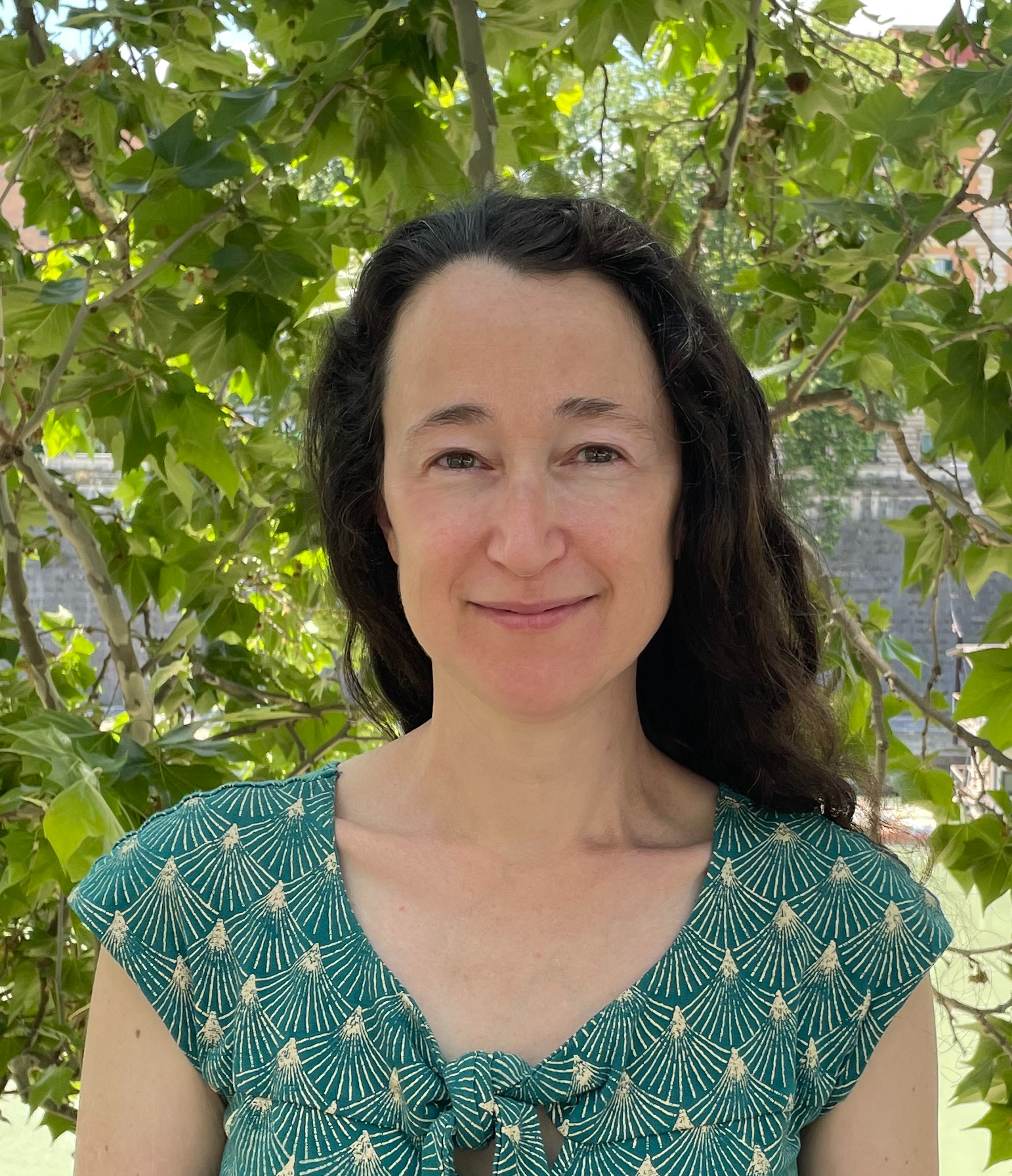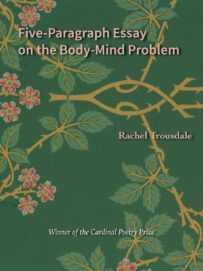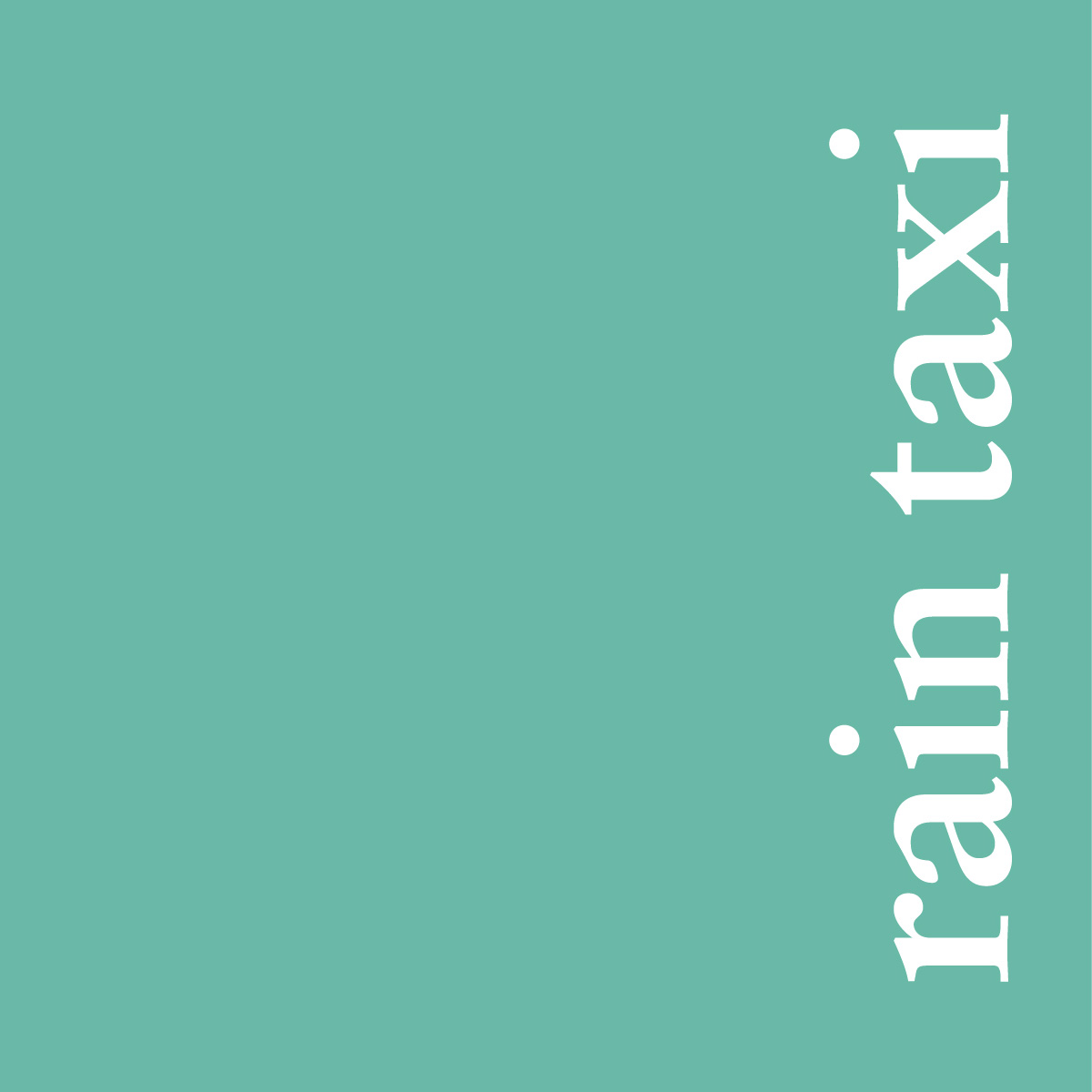
 Rachel Trousdale is a poet and scholar; her critical studies to date include Humor, Empathy, and Community in Twentieth-Century American Poetry (Oxford University Press, 2021) and Nabokov, Rushdie, and the Transnational Imagination (Palgrave, 2010), as well as the essay anthology Humor in Modern American Poetry (Bloomsbury, 2017). Her debut full-length collection of poems, Five-Paragraph Essay on the Body-Mind Problem (Wesleyan University Press, $15.95), was selected by Robert Pinsky for Wesleyan University Press’s inaugural Cardinal Poetry Prize. Inhabited by crows, yetis, coral reefs, and aliens, these poems playfully examine the intensity and conflict of romantic love, the entropic joys of parenthood, illness and grief, and the ways our physical loves and intangible losses teach us responsibility to the world around us and illuminate our most important relationships—whether with other humans, wild spaces, or works of art.
Rachel Trousdale is a poet and scholar; her critical studies to date include Humor, Empathy, and Community in Twentieth-Century American Poetry (Oxford University Press, 2021) and Nabokov, Rushdie, and the Transnational Imagination (Palgrave, 2010), as well as the essay anthology Humor in Modern American Poetry (Bloomsbury, 2017). Her debut full-length collection of poems, Five-Paragraph Essay on the Body-Mind Problem (Wesleyan University Press, $15.95), was selected by Robert Pinsky for Wesleyan University Press’s inaugural Cardinal Poetry Prize. Inhabited by crows, yetis, coral reefs, and aliens, these poems playfully examine the intensity and conflict of romantic love, the entropic joys of parenthood, illness and grief, and the ways our physical loves and intangible losses teach us responsibility to the world around us and illuminate our most important relationships—whether with other humans, wild spaces, or works of art.
Stephanie Burt: Often your poems make me smile, or grin, or laugh; they make unserious, loving requests, or playful allusions, or absurd leaps. You’re known as a scholar and critic of humor in modern poetry. How does your scholarship on the topic speak to your poems that embody it?
Rachel Trousdale: My scholarship focuses on laughter that comes from fellow-feeling. While we can laugh for a thousand reasons—embarrassment, confusion, aggression—the laughter I’m most interested in comes when you suddenly recognize part of yourself in someone else. I’m also a big fan of the improvisational comic riff, which gains its humor from surprising variations on a theme; when this works, it can make a whole new pattern snap into shape. When my poems are funny, I hope it’s because they’re doing one of those things—not so much playing with comic incongruity as finding surprising congruences.
SB: In “Optics Lab,” you write, “That’s how you make sestinas—with a laser.” When and how do you see your own poems as made things, as craft objects? When and how do you see them as kinds of speech, as communication in time between persons, instead? Is there even a difference?
RT: I like to make things with my hands. I bake bread; I used to make pottery; I’ve recently started sewing. The purpose of baking bread is to nourish and to give pleasure, and even if I eat the whole loaf myself, the bread can achieve this goal—but it’s better when it’s shared, because if I give slices of bread to my kids and they slather them with butter and eat them, I get the additional pleasure of watching people I love enjoy the food, and the nourishment takes more forms.
It’s the same with poems. If I write a poem and am satisfied with it, that is probably because I’m happy with it as a made object: its parts fit together in a way I find pleasing. So in that sense, I think all my poems are craft objects, even if the “craft” elements are not always the kind of thing you’d talk about in, say, a craft class. But I’m happiest when the poem is also talking to someone who is not myself, whether that someone is a real-world reader or the ghosts reading over my shoulder. Of course, the best of all is when you get a response.
SB: Your life has led you to many places, and to more countries than most of us get to visit. How have those travels informed your approach to writing poems?
RT: One of the things travel teaches you is to question your premises. When you’re in an unfamiliar place, especially somewhere you don’t speak the language, questions as simple as “Where is the coffee?” and “How do I get a ride to this address?” can turn into research projects or philosophical enquiries. Did you know that building numbers in Tokyo are assigned by the order in which they were constructed within a given block, rather than by their relative locations? So the simple task of trying to get across town turns out to be a challenge to your sense of order and structure. I hope some of my poems do something similar.
SB: Your lovely and gentle“Self-Portrait as Noble Pen Shell” constitutes a response to which of the following: a. Keats’s “To Autumn”; b. Marianne Moore’s “The Paper Nautilus”; c. Marianne Moore’s “The Fish”; d. William Carlos Williams’s “By the road to the contagious hospital”; e. Come off it, Stephanie! Please select one and only one answer. Explain the reasons for your choice.
RT: The answer is absolutely B, which stands for Bizarre, because it is bizarre to write a response to “The Paper Nautilus” that (on the surface) lacks mothers and children. But they’re both about protecting something fragile, and the threat of starvation, and hope.
SB: Works for me. What’s the difference between writing (and revising) a prose poem and a lineated poem? Do their shapes work, for you, in different ways? How do you know when a prose poem is finished?
RT: There’s no room for talkiness in a prose poem, because if you let extra words in, it starts behaving like regular prose. And you don’t have the luxury of line breaks as a way to build in surprises and double meanings, so you have to make the most of other opportunities for multiplicity. I find prose poems much harder to write and am somewhat surprised to discover how many I’ve written, because you can’t depend on the form to keep your focus.
SB: Some humor sounds Jewish. Some Jews sound humorous. Almost all Jews have a humerus. You and I identify as Jewish. Does some of your humor, to you, sound Jewish? Or Jewish American?
RT: My sense of humor is probably the most Jewish thing about me. I learned to love puns, irony, comic critique, and playful rhyme from family members like my songwriter uncle John Meyer, from Sondheim and Gershwin lyrics, and from the inspired, anti-authoritarian nonsense of the Marx Brothers. “Old Joke” in particular isn’t just a Jewish poem, it’s a New York Jewish poem. But as with the Marx Brothers, you don’t have to be Jewish to get the jokes; what I think of as the Jewishness of my humor isn’t a set of references so much as a set of comic techniques—particularly the ironic deflation of pretense and the free-associative crescendo.
SB: Your astonishing and generous “Syllabus” constitutes a response to which of the following: a. The dearth of poems about raising and caring for more than one child; b. Robert Frost’s “Directive”; c. Keats’s “La Belle Dame Sans Merci”; d. The emotional challenge of raising children during the reign of our current Mad King; e. That Robert Hass poem with the blackberries that absolutely everyone used to read until we got tired of it (complimentary); f. Sarah Morgan Bryan Piatt’s “The Palace-Burner.” Please select only one answer, and please justify your choice.
RT: The letters b and d are mirror images of each other, so if I choose one, the other is implied. When “Directive” walks you up the mountainside, it’s walking you backwards, past all those slowly closing cellar-holes, to a lost play house. In “Syllabus,” my little family of four is all walking together away from the house, the rest of the way up the hill, to learn the names of things and what you can eat. “Directive” is about nostalgia, looking back to the children; “Syllabus” is—I hope—about looking forward, with the children, toward a future where we will have to know far too much about Mad Kings but where there will also be blackberries.
SB: Well now I’m alarmed, since Robert Frost’s “Directive” is the scariest poem in the American language: dude wants to kill us. You, however, can save some of us! No, really, you can. Please don’t feel you should have to justify anything in the following answer, but can you talk about justifications, defenses of poetry, and the moral charge (or lack of it) underlying your delightful verse and prose?
RT: Some time in the fall of 2020, after the summer of shutdowns, the small bakery near our house reopened, and we were able to go in again and buy cupcakes. It completely changed my relationship with art and what art is for. My spouse and I had spent the previous few months holding on by our teeth, working full-time jobs from home with no childcare for our preschool-aged children and worrying about our elderly parents. And now here was a tiny transaction we could make, in person, that resulted in pure, unambiguous pleasure. It was the best thing to happen to us for months. And I thought: I want my poems to do this for people—I want to make moments of definite happiness. Because joy isn’t trivial, even if the things that make it can seem silly. Good poems aren’t all cheerful, and they mostly don’t have rainbow sprinkles on top, but they are just as necessary and important as cupcakes.
SB: Most of your references in Five-Paragraph Essay speak to the sort of literature you might expect an English department to teach, from King Lear to Robert Frost and WCW. You’ve also read a great deal of non-realist fiction, including work in (or else adapted from) Russian literature as well as folk and fairy tales. Do any of those kinds of writing and storytelling influence these poems in ways that we might not see?
RT: It’s funny—when you asked about Moore earlier, it made me realize that many of the overt Norton Anthology-style references in this book are to poets I want to argue with. I’ve been tempted to offer a prize to the first student who correctly identifies the three obvious Shelley references in the book. (The prize is homemade brownies. Email me. Undergraduates only.) But Shelley isn’t one of the poets whose books I open when I read for pleasure or company—he’s part of the Big Intellectual History that goes into the classes I teach—whereas Keats is much harder to find in my book, although his poems are the ones I actually recite to myself for comfort at the dentist. No one has influenced my work more than Moore, but her presence is less obvious.
And yes, I read non-realist fiction of many stripes, including Angela Carter, Salman Rushdie, Mikhail Bulgakov, and Andrew Lang’s rainbow of fairy books. Rushdie and Bulgakov, for me, perform some of the same transformative associative leaps I admire in the Marx Brothers, or in the poetry of Harryette Mullen—creating patterns which combine long-established meanings and references on the one hand with the fruits of coincidence on the other. And, as a counterweight, a fair amount of science writing: Oliver Sacks, or Einstein’s general-audience book on relativity, which, despite their totally different content, sometimes follow a similar process of discovery.
SB: What’s the best Andrew Lang fairy book? Or the right first one for people who never got given Girls’ Books when we were girls? Your magnificent and open-ended “Narrative of the Tribal Bard” responds to which of the following: a. Robert Frost’s “Mending Wall”; b. Kenneth Koch’s “Mending Sump”; c. Recent scholarship on the high intelligence and social behavior of crows; d. Watership Down; e. Geoffrey Chaucer’s “Parliament of Fowls”; f. Ursula K. Le Guin’s Five Ways to Forgiveness. Please do NOT try to justify your choice.
RT: None of the above: “Narrative of the Tribal Bard” is a direct translation from the cawing of the crows in my yard. I should probably have disclosed in the notes that I don’t actually speak Caw and am working entirely from Corvo’s New Standard Caw-English Dictionary, but I think I’ve captured the essence.
SB: I’m not going to trust any dictionary compiled by Baron Corvo, but OK. Your pentameters and your Sapphics sound fluently conversational, and your free verse (like Bishop’s, Hayes’s, MacNeice’s) plays off against the background of the pentameter. Can you tell us something about your metrics, or about your relationship to received metres?
RT: The first poems I wrote were all strictly metrical, and like a lot of us, I find meter useful in part because it reminds me to find the right word. I’m glad I didn’t start by writing free verse, because the years I spent writing only in meter helped me learn to concentrate. But that’s an answer about meter as method of composition, as opposed to meter as a formal element of poetry.
SB: You get to spend the next six months anywhere on Earth, so you can write your next book of poems there. You can’t take your kids or loved ones, but they will not know you’re gone, due to faerie time distortion; you’ll get back home, from their perspective, just two days after you left, so it’s not irresponsible to go, and you don’t have to pick your location with their welfare in mind. Where do you go, and why? How does the site affect the poems you write next?
RT: Fortunately, faerie time distortion also distorts space, which means I can find an isolated mountain cabin within twenty minutes’ walk of a major research library. I would like to go there, please. I will arrive with a clear proposal for a manuscript about the local birds’ foraging behavior, but when the six months are up I’ll discover that instead I’ve written a series of love poems to my absent family in the form of a medieval recipe book featuring ingredients I was able to raise in the little garden behind the cabin.
SB: Sometimes I think you and I share tastes and preferences and then I run into an answer like that, which reminds me that even our close friends contain Bizarre Hidden Depths. Watch out for Robert Frost, who might be hiding in the sugar bushes. What’s in the recipe book? More seriously, or perhaps less seriously: What’s next for your poetry?
RT: I’ve been working on a sequence of poems giving the answers to questions asked of an imaginary advice column. Just the answers, not the questions. Galileo writes in for help, and several characters from fairy tales. One of the poems, “Dear Ilsabil,” made it into Five-Paragraph Essay, but I think the rest may want to be a chapbook, or the skeletal system of a longer manuscript. But more generally, I want to write things I haven’t read yet.
Click below to purchase this book through Bookshop and support your local independent bookstore:
Rain Taxi Online Edition Summer 2025 | © Rain Taxi, Inc. 2025
